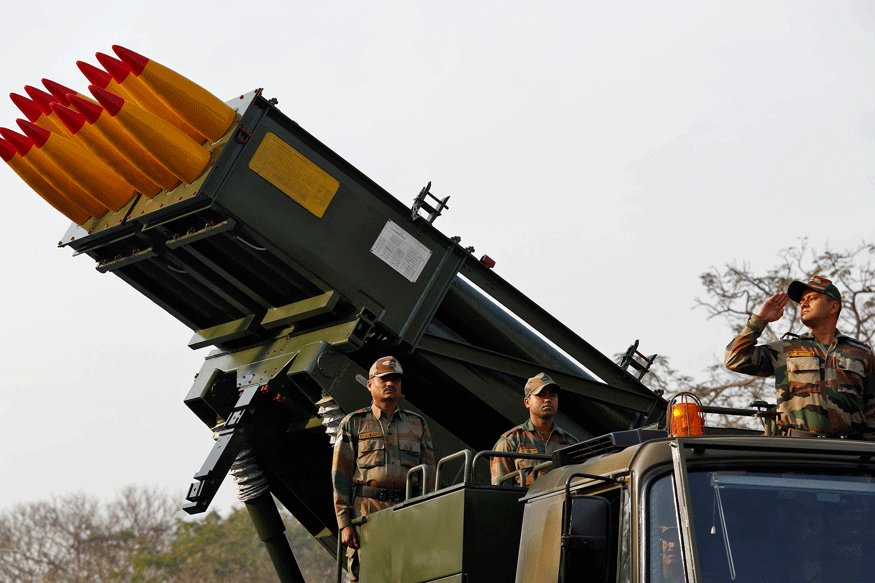Details of the policies and the steps taken for manufacturing of state-of-the-art defence products are:
- Self-reliance is a major corner-stone on which the military capability of any nation rests. Accordingly, the Defence Production Policy promulgated by the Government, aims at achieving substantive self-reliance in the design, development and production of equipment, weapon systems, platforms required for defence in as early a time frame possible, creating conditions conducive for private industry to play an active role in this endeavour; enhancing potential of SMEs in indigenisation and broadening the defence R&D base of the country.
- Defence Production in India is led by Ordnance Factories and Defence Public Sector undertakings which have played a huge role in making our country a defence manufacturing hub. There are 41 Ordnance Factories and 9 DPSUs in our country contributing to more than Rs.58,000 crores approx. in defence production every year. Government provides support to Defence Public Sector Undertakings and Ordnance Factories to expand their activities.
- In view of the aforesaid Defence Production Policy and ‘Make in India’ initiative, several policy initiatives have been taken for promoting manufacturing of State-of-the-art defence products. These include:-
- Innovations for Defence Excellence (iDEX): An innovation ecosystem for Defence titled Innovations for Defence Excellence (iDEX) has been launched in April, 2018. iDEX is aimed at creation of an ecosystem to foster innovation and technology development in Defence and Aerospace by engaging Industries including MSMEs, Start-ups, Individual Innovators, R&D institutes and Academia and provide them grants/funding and other support to carry out R&D which has potential for future adoption for Indian defence and aerospace needs. Under iDEX, innovative solutions have been successfully identified for 14problem areas pertaining to national defence requirements. More than 600 startups have been engaged in the process and 44 different solutions have been identified by the innovators for the problem statements given by Armed forces/Defence Units.
- Foreign Direct Investment (FDI): FDI Policy has been revised and under the revised policy, FDI is allowed under automatic route upto 49% and beyond 49% through Government route wherever it is likely to result in access to modern technology or for other reasons to be recorded.
- Government has notified a Policy for indigenisation of components and spares used in Defence Platforms in March, 2019 with the objective to create an industry ecosystem which is able to indigenize the imported components (including alloys & special materials) and sub-assemblies for defence equipment and platform manufactured in India.
- The Defence Products List for the purpose of issuing Industrial Licenses (ILs) under IDR Act has been revised and most of the components, parts, sub-systems, testing equipment and production equipment have been removed from the list, so as to reduce the entry barriers for the industry, particularly small & medium segment. The initial validity of the Industrial Licence granted under the IDR Act has been increased from 03 years to 15 years with a provision to further extend it by 03 years on a case-to-case basis. So far, the process for export clearance has been streamlined and made transparent & online.
- Mission Raksha Gyan Shakti: The Ministry has instituted a new framework titled ‘Mission Raksha Gyan Shakti’ which aims to provide boost to the IPR culture in indigenous defence industry.
- Technology Development Fund: Government has set up the Technology Development Fund (TDF) to encourage participation of public/private industries especially MSMEs, through provision of grants, so as to create an eco–system for enhancing cutting edge technology capability for defence applications
- Provisions in Defence Procurement Procedure (DPP-2016): Additionally, several enabling provisions have been incorporated in the DPP-2016 for promoting manufacture of the State-of-the-art defence products and technologies and transfer of state-of-the-art defence technology to India, which are as under :-
- Buy (Indian-IDDM) in Defence Procurement Procedure (DPP-2016): A new category of procurement ‘Buy {Indian-IDDM (Indigenously Designed, Developed and Manufactured)}’ has been introduced in DPP-2016 to promote indigenous design and development of defence equipment. It has been accorded top most priority for procurement of capital equipment. Besides this, preference has been accorded to ‘Buy (Indian)’, ‘Buy and Make (Indian)’ & ‘Make’ categories of capital acquisition over ‘Buy (Global)’ & ‘Buy & Make (Global)’ categories.
- ‘Make’ Procedure: The ‘Make’ Procedure has been simplified with provisions for funding of 90% of development cost by the Government to Indian industry and reserving projects not exceeding development cost of Rs.10 Crore (Government funded) and Rs.3 Crore (Industry funded) for MSMEs.
- Separate procedure for ‘Make-II’ sub-category has been notified wherein a number of industry friendly provisions such as relaxation of eligibility criterion, minimal documentation, provision for considering proposals suggested by industry/individual etc., have been introduced. Till date, 36 proposals for development by industry have been given ‘in-principle’ approval under Make-II.
- Defence Offsets: Offset guidelines have been made flexible by allowing change of Indian Offset Partners (IOPs) and offset components, even in signed contracts. Foreign Original Equipment Manufacturers (OEMs) are now not required to indicate the details of IOPs and products at the time of signing of contracts. ‘Services’ as an avenue of offset have been re-instated
- Strategic Partnership (SP): Government has notified the ‘Strategic Partnership (SP)’ Model which envisages establishment of long-term strategic partnerships with Indian entities through a transparent and competitive process, wherein they would tie up with global Original Equipment Manufacturers (OEMs) to seek technology transfers to set up domestic manufacturing infrastructure and supply chains.
- Buy and Make (Indian): The Buy & Make (Indian) category has a provision for procurement from an Indian vendor engaged in a tie-up with a foreign OEM, involving Transfer of Technology (ToT) of critical technologies.
- Buy and Make: The “Buy & Make” category has provision for procurement from a foreign vendor, through an Indian Production Agency (PA), involving Transfer of Technology (ToT) of critical technologies.















